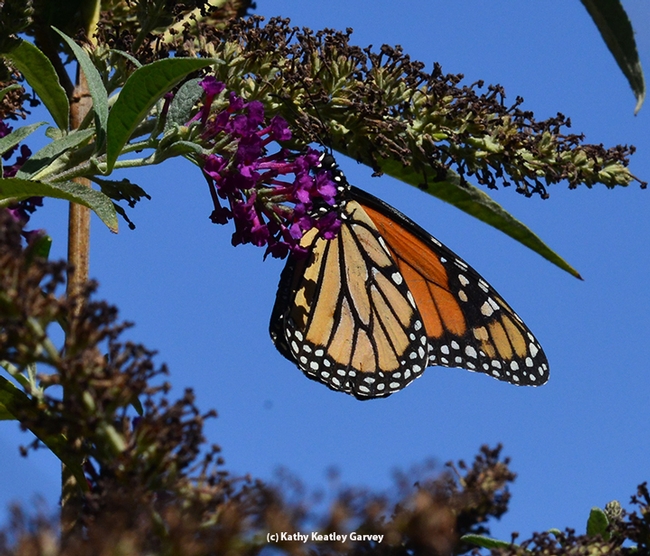- Author: Kathy Keatley Garvey
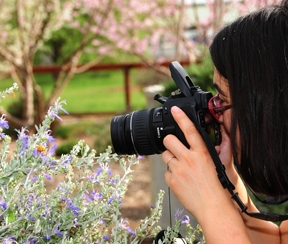
They go together like honey bees on bee balm and bumble bees on tomatoes.
When you attend the 102nd annual campuswide UC Davis Picnic Day on Saturday, April 16, be sure to head over to Briggs Hall, Kleiber Hall Drive, to see the Pollinator Pavilion, which will emphasize the importance of pollinators in both natural environments and food production.
"It is often said that one in every three bites of food we take is dependent on animal pollination," said Pavilion Pollinator coordinator Margaret "Rei" Scampavia, a doctoral candidate in entomology. "While there are some foods that do not rely on animal pollination, many of the tastiest and most nutritious food does. To this end, we have a series of posters demonstrating what a meal might look like with and without foods that benefit from animal pollination."
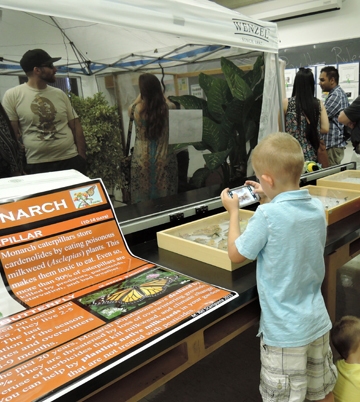
"We are going to have a series of exhibits showcasing pollinator diversity, demonstrating their importance in natural ecosystems and food production, and providing information on what members of the general public can do to help native pollinators," Scampavia said.
"We will have information on a wide variety of animal pollinators, including butterflies, flies, wasps, birds, and even bats. But the majority of the exhibit will focus on the most abundant pollinators: native bees."
The highlight is the walk-in Pollinator Pavillion, an enclosure where visitors can "safely view live pollinators, such as bees, butterflies and flies, up close and in person," the entomologist said. "Younger guests can practice scientific observation by filling out specially provided data sheets. Some of the species present will include: blue orchard bees, Monarch butterflies, Red Admiral butterflies, and Painted Lady butterflies."
Scampavia points out that the European honey bee "is the first thing many people think of when they hear the word pollinator. But in reality, this species is only one of tens of thousands of pollinator species; there are more than 20,000 species of bee besides the honeybee, for example. We hope that visitors to this exhibit will leave with a greater appreciation of the amazingly diverse animals that pollinate flowers."
Last year scores of enthusiastic visitors packed the Pollinator Pavilion. It proved to be one of the most popular, well-crafted, well-designed Picnic Day displays. Another eagerly anticipated event awaits Saturday.
And now there's an urgency.
"Many pollinator species are experiencing alarming declines," Scampavia said. "Monarch butterflies, for example, have declined by over 90 percent in the past ten years. To promote awareness of the plight of the Monarch, we have a series of exhibits with live caterpillars, chrysalises, and adults, which also contain important information about this species and what we can do to prevent further losses. There will also be information about ways to enhance outdoor spaces to promote and sustain healthy wild, native pollinators."


- Author: Kathy Keatley Garvey
We're not the only ones "celebrating" the first week of spring. The oleander aphids are doing a happy dance on our milkweed plants. We think they're doing a mixture of the tango, cha-cha-cha, salsa and merengue. Every time we walk past them, we see a population explosion with even more incredible dance moves. In population size, they went from a family reunion to an army of aphids to an international conference. Y'all come.
These are yellow, pear-shaped insects, about 1.5 to 2.6mm long, with black cornicles. They congregate on the tender young shoots and suck the very life out of them.
Now it's our job to suck the very life out of the aphids before the monarch butterflies return. There are many ways to do this. We sometimes pick them off, squishing them between our fingers. Or we invite lady beetles (aka ladybugs) and soldier beetles to pick them off--but sometimes they're not around to accept our invitations.
Actually we prefer to wash their mouths out with soap. Fill a spray bottle with a gallon of water, add a teaspoon of liquid dishwasher and spray away. The aphids are goners. Some folks add a pinch of cayenne pepper for good measure. Probably makes them more lively when they dance the salsa?
Today when we checked our milkweeds, the population had dwindled down to one aphid. Just one. A one-delegate conference with no flashy moves. It takes two to tango.
Related Links:
For information on how to control aphids, check out the UC Statewide Integrated Pest Management Program's website.
For information on rearing monarchs, including recommended ways to rid your milkweed of those pesky aphids, these Facebook pages are quite helpful:
The Beautiful Monarch
Public group administered by Holli Webb Hearn
"The Beautiful Monarch group was created to teach members how to raise and properly care for the monarch butterfly from egg to flying adult along with learning about their predators, diseases and other monarch facts. It is my hope that as a collective group we will help and teach one another along with any new members that join us."
Raising Butterflies and Moths for Conservation (+All Pollinators)
Closed group monitored by Mona L. Miller (apply to join)
"Our focus is the preservation and protection of North American butterflies, moths and pollinators, particularly the Monarch Butterfly.")


- Author: Kathy Keatley Garvey

You're yearning to see monarch eggs, caterpillars and chrysalids on milkweed. Ditto for the pipevine swallowtails on their host plant, Dutchman's pipe.
You also want some butterfly bushes and other nectar plants.
And you're thinking of replacing your drought-stricken lawn with drought-tolerant plants.
You're in luck!
The UC Davis Arboretum Plant Sale is Saturday, Oct. 24 from 9 a.m. to 1 p.m. at the Teaching Nursery on Garrod Drive. (See directions)
"We're going to have a lot plants -- over 16,000 – including lots of Arboretum All-Stars in honor of their 10-year anniversary," spokesperson Katie Hetrick told us today.
The All-Stars are 100 specially selected plants "that have provided California with a foundation for creating attractive, easy-care landscapes that save water." A large selection of Arboretum All-Stars, California natives, and other regionally appropriate plants will be available.
The public sale offers benefits for Arboretum members, who can save 10 percent. Non-members can join at the door. For additional information, see benefits of memberships.
What's available at the plant sale? Is there a list? Yes, and folks are checking it twice! You can access it on the website or download the PDF.
While you're on the campus, you can explore the 100-acre UC Davis Arboretum, a horticultural and cecreational treasure filled with scientific collections, demonstration gardens, educational information and art work. You can walk or bike the trails. Bring your camera.
If you're lucky, a monarch will flutter by.



- Author: Kathy Keatley Garvey
Last Dec. 27 at the Natural Bridges State Park, we saw dozens of monarchs about 80 feet up in the eucalyptus trees. When the sun broke through the trees, assorted birds targeted them, scattering them like mosaic paper kites, much to the awe and aahs of the crowd below.
"Monarch butterflies are among the largest members of the family Nymphalidae in North America. Their caterpillars store toxic chemicals called cardiac glycosides in their bodies from the milkweed they eat. Cardiac glycosides make vertebrates like us quite sick, so don't eat a monarch butterfly or caterpillar if you can help it. The chemicals remain in the adult butterfly bodies as well but tend to be concentrated more in the wings than in the body. Interestingly, cardiac glycosides seem to have very little effect on insect predators and parasites."
"The annual North American migration begins as early as August. Populations west of the Rockies migrate to the Pacific Coast with overwintering roosts along the central California coast. One of the best known of these is in Pacific Grove, California. Populations east of the Rockies migrate to central Mexico. Adult monarchs typically only live a couple of months, although they can live up to 5 or 6 months so the individuals that emerge in early summer do not migrate. Each generation takes between 5 and 6 weeks from egg to adult. The last generation of the summer goes into migratory mode. They stop reproducing and fly in a linear fashion to one of the overwintering sites. These individuals generally do not begin reproducing until the following spring in February or March when they leave these sites and move north from the Mexican site or north and east from the Pacific Coast."
Welcome back, monarchs! You're now fueling up for mass migration.
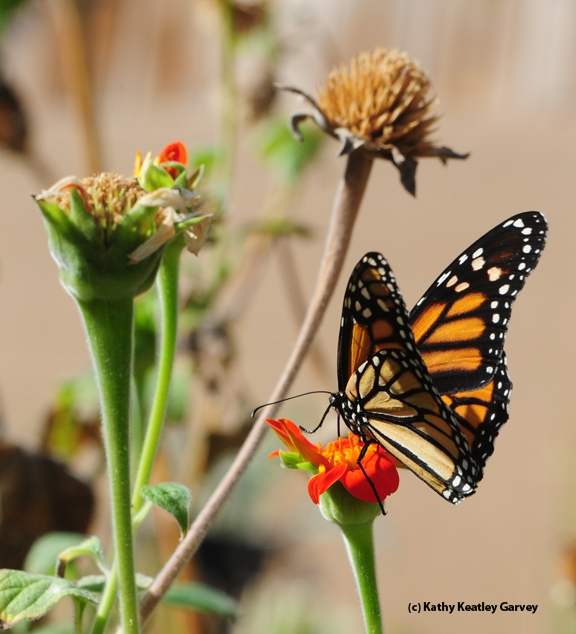
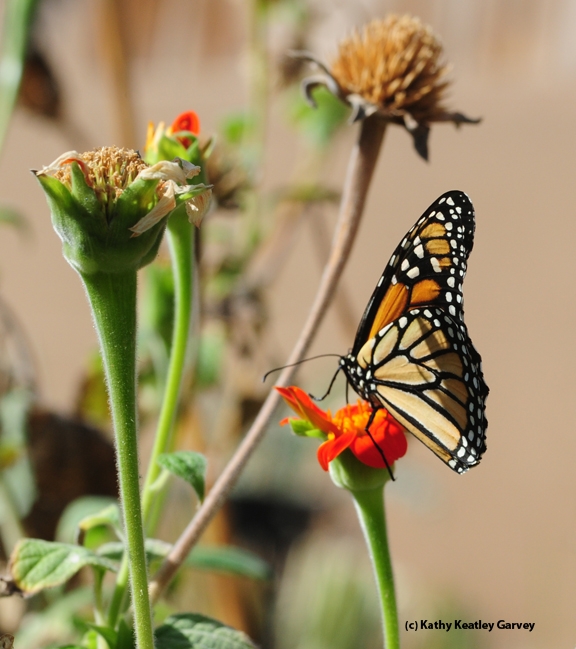
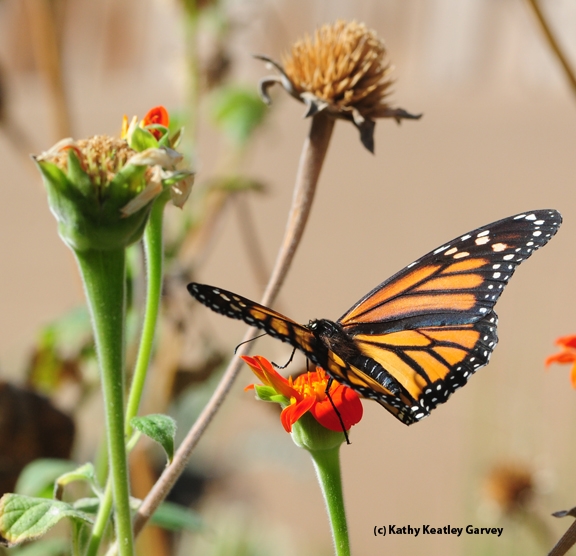

- Author: Kathy Keatley Garvey
The Monarchs are on the move.
In the late summer and early fall, the Monarchs (Danaus plexippus) head for the California coastline or central Mexico to overwinter.
"Monarchs west of the Rocky Mountains travel to small groves of trees along the California coast," according to Monarchwatch.org. "Those east of the Rocky Mountains fly farther south to the forests high in the mountains of Mexico. The Monarch's migration is driven by seasonal changes. Daylength and temperature changes influence the movement of the Monarch." See map.
It's a good day when we see a single monarch in our Vacaville, Calif. garden re-fueling for the migration. It's a great day when we see two. It's a super, super wonderful day when we see three. It's a time for cartwheels, handstands and pirouettes.
Only a Monarch can get us that excited. Gulf Fritillaries, Western Tiger Swallowtails, and Anise Swallowtails come close. Mourning Cloaks, Painted Ladies and Acmon Blues? Not so much.
The aptly named butterfly bush (Buddleja davidii) draws them all, offering nectar they can neither resist nor refuse. Another nectar favorite in our garden is the Mexican sunfllower (Tithonia).
The female Monarchs are still laying eggs on our milkweed. The result: two chrysalids are hanging in our butterfly habitat container (purchased from the Bohart Museum of Entomology, University of California, Davis),
Soon, we hope, two more adults will begin that amazing migratory journey to Santa Cruz? Pacific Grove?
Who knows? Right now they're precious jade-green jewels studded in gold. We can see the outlines of the treasures they hold.



